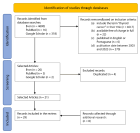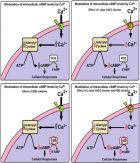About Edo State University
Edo State University
Articles by Edo State University
Assessment of cardiovascular and renal functions during treatment with Desmodium adscendens therapy
Published on: 9th June, 2020
OCLC Number/Unique Identifier: 8873221073
Desmodium adscendens is a rain forest medicinal herb used in managing quite a number of medical conditions. Its efficacy in the treatment of several diseases has made it a first line herb for doctors, especially in managing all forms of spasm. It is however common knowledge that some of these medicinal herbs impact severely on the normal functioning of some vital organs of the body during their administration. The present study was carried out to assess the renal and cardiovascular performance in subjects undergoing treatment with Desmodium adscendens with a view to advising against its indiscriminate use. The parameters used for the assessment of renal functions were serum creatinine and urea concentrations and their clearance. Also, changes in electrolyte concentration of Sodium, Potassium and Chloride concentration were used to assess cardiovascular performance. The histology of the kidney and heart tissues was also done to determine if the extract has impact on the cyto-architecture of the organs. Twenty-four (24) wistar rats were used for the experiment. The rats were grouped randomly into four groups (n = 6). Group 1 served as control, and the rats in the group were given normal rat feeds and water. Group 2 served as low dose group, and rats in this group were administered with low dose of extract 300 mg/kg. Group 3 served as medium group, and rats in this group were treated with medium dose of extract, 450 mg/kg. Group 4 served as high dose group, and rats in this group were treated with high dose of extract 600 mg/kg. The extract was administered for 28 days. Result showed that the extract did not impact negatively on the normal function of the renal and cardiovascular system of the treated groups, rather it enhanced their performances. It can therefore be concluded that the extract is beneficial to renal and cardiovascular functions if used within the treatment dosage.
Sildenafil citrate in healthy and diseased hearts
Published on: 23rd April, 2021
OCLC Number/Unique Identifier: 9026743533
Sildenafil citrate is one of the frontline drugs used to manage erectile dysfunction (ED). Chemically, it is described as 1-[[3-(6,7-dihydro-1-methyl-7-oxo-3-propyl-1H –pyrazolo [4,3-d]pyrimidin-5-yl)-4 ethoxyphenyl] sulfonyl]-4-methylpiperazine citrate (C22H30N6O4 S). It is a highly selective inhibitor of cyclic guanine monophosphate-specific phosphodiesterase type-5. There had been heightened concerns following reports that sildenafil citrate may increase the risk of cardiovascular events, particularly fatal arrhythmias, in patients with cardiovascular disease. So the cardiac electrophysiological effects of sildenafil citrate have been investigated extensively in both animal and clinical studies. This article ties up the various outcomes of the investigations with a view to guiding physicians and patients that use sildenafil citrate to manage erectile dysfunction, especially as it concerns its effect on their cardiovascular function in health and in disease. Sildenafil citrate could impact negatively on ailing hearts, but on a healthy heart, there may not be any such impact, rather, it improves on heart performance as it lowers the blood pressure.
Impact of amitriptyline on learning and memory
Published on: 14th April, 2021
OCLC Number/Unique Identifier: 9026719804
Background/aim: Amitriptyline belongs to class of known as tricycline antidepresant (TCA) that is being used to treat anxiety and depressive states. It may help improve mood and feelings of well-being, relieve anxiety and tension, help to improve sleep and increase energy level. The study investigated the effect of amitriptyline on learning and memory using eighteen (18) healthy Swiss mice of both sexes weighing 16 – 25 g.
Method: The animals were divided into three (3) groups consisting of six (6) animals each. Group 1 served as the control group, Group 2 was administered with amitriptyline at a dose of 3 mg/kg body weight dissolved in 3 mls of distilled water, and used to test for learning, while Group three was also given similar administration like Group 2, but used to test for memory. All the animals were tested for learning and memory performance using Novel object recognition task and Morris water maze test.
Results: The results obtained from the Novel object recognition task showed that there was a significant decrease (p < 0.05) in total object approach in acquisition trial of amitriptyline treated group when compared to the acquisition trial of the control group. There was a significant decrease (p < 0.05) in retention trial of amitriptyline group when compared to retention trial in the control group. There was a significant decrease (p < 0.05) in total duration exploring objects in acquisition trial of amitriptyline treated group when compared to the acquisition trial of the control group. There was a significant increase (p < 0.05) in total duration exploring objects in retention trial of amitriptyline treated group when compared to the retention trial of the control group. There was a significant decrease (p < 0.05) in the index of habituation of amitriptyline treated group when compared to the control group. The index of discrimination showed a significant increase (p < 0.05) in amitriptyline treated group when compared to the control group and a significant decrease (p < 0.05) in amitriptyline group when compared to the control group. In the Morris water maze test, Day 1 – 3 were for acquisition training, day 4 – 6 reversal training, day 7 the probe trial day and day 8 the visible platform day. During acquisition training in the Morris water maze test, there was no significant difference in Swim latencies in day 1 and 2. However in day 3, there was a significant increase (p < 0.05) in swim latency of group compared to control group and a significant decrease (p < 0.05) in swim latency of amitriptyline treated group compared to the control group. During reversal training in day 1, 2 and 3, there was no significant difference in swim latency among the three groups. Results for the retention quadrant in the probe trials showed a significant decrease (p < 0.01) in amitriptyline group when compared to the control group.
Conclusion: Results suggest that amitriptyline impairs learning and memory functions.
Age, smoking, hypertension, and aortic aneurysm: Interactions and risks
Published on: 6th January, 2022
OCLC Number/Unique Identifier: 9391753907
Background/Aim: Aortic aneurysm is the bulging of a weakened portion of the aorta. The aorta is the major blood vessel that feeds blood (carrying oxygen, nutrients and water) to the tissues of the body. When a portion of the wall of the aorta becomes weak, blood pushing against the vessel wall can cause it to bulge like a balloon (aneurysm) leading to aortic dissection (a tear in the wall of the aorta that can cause life-threatening bleeding or sudden death). Blood pressure is the force arterial blood exerts on the wall of the artery. When this pressure is consistently high above 140/100 mmHg it is referred to as hypertension. As an individual gets older over time, physiological functions of the body depreciate leading to some abnormalities. Smoking is the consumption of tobacco mostly by inhalation of the smoke that is produced from burning the tobacco. This review article examines the close interactions between age, smoking, hypertension and aortic aneurysm, with a view to understanding mechanisms by which these factors predispose a patient to an aortic aneurism. It is also to observe if these factors interfere with treatment and recovery from aneurysms. Conclusion: After careful review, it is observed that age and smoking are risk factors for hypertension, and together with hypertension, the three factors predispose an individual to high risk for aortic aneurysm.
A Comparative Study of Serum Sodium and Potassium Levels across the Three Trimesters of Pregnancy
Published on: 10th August, 2023
Aim: To evaluate the serum sodium and potassium levels in the three trimesters of pregnancy in women. Methods: Four groups of healthy women between the ages of 20 and 30 years, volunteered for this study. Group 1: Non-pregnant women (control), Group 2: Pregnant women in their first trimester, Group 3: Pregnant women in their second trimester, Group 4: Pregnant women in their third trimester. Blood samples were collected by standard aseptic method and serum samples were analyzed for serum levels of sodium and potassium by the ion selective electrode method. Results were presented as MEAN ± SEM in tables and figures, p < 0.05 was regarded as statistically significant. Results: The serum sodium concentrations in mmol/L were 135.3 ± 3.09, 136.3 ± 1.55, 139.0 ± 0.78, 139.8 ± 0.91 for control, first-trimester, second-trimester, and third-trimester subjects respectively. The potassium concentrations in mmol/L were 3.678 ± 0.26, 3.687 ± 0.13,3.820 ± 0.11, 3.767 ± 0.07 for control, first-trimester, second trimester and third-trimester subjects respectively. The Bodyweight values in kg were 72.13 ± 2.11, 74.73 ± 2.05, 75.00 ± 1.72, 81.56 ± 4.24 for control, first-trimest, second-trimester, and third-trimester subjects respectively. Conclusion: Results indicate that the hormones of pregnancy altered the body weight of pregnant women, but did not change the serum sodium and potassium level across the three trimesters of pregnancy in women. This is an indication that the kidneys of healthy pregnant women can handle serum electrolyte load during the period of pregnancy.
Assessment and Correlation of Serum Urea and Creatinine Levels in Normal, Hypertensive, and Diabetic Persons in Auchi, Nigeria
Published on: 16th August, 2023
Background/Aim: There has been a progressive rise in the incidence and prevalence of End Stage Renal Disease (ESRD). It has also been observed that the most important reasons for a rapid increase in Chronic Kidney Disease (CKD) patients are the rapidly increasing worldwide incidence of diabetes and hypertension. The present study evaluates the effect of diabetes, hypertension, and comorbid state of hypertension and diabetes (hypertensive-diabetic) on renal function using serum creatinine and urea as markers. Method: A total number of 120 persons were recruited for the research; 30 controls, 30 hypertensive, 30 diabetic, and 30 hypertensive-diabetic persons. Of the 30 control persons, 18 were females and 12 were males; of the 30 hypertensive subjects, 17 were females and 13 were males; of the 30 diabetics subjects, 20 were females and 10 were males, whereas of the 30 hypertensive-diabetic subjects, 21 were females and 9 were males. In total, there were seventy-six (76) females and 44 males. The respondents were pulled from Central Hospital (Auchi) Diabetic and General Clinic and Auchi Polytechnic Cottage Hospital. Verbal consent was sort and questionnaires were used to extract information regarding biodata and patients’ history of diabetes and hypertension. Height and weight were measured, and blood pressure was determined taken. Blood samples were collected into fluoride oxalate and lithium heparin bottle for the assessment of FBS and (serum urea and creatinine) respectively. Results: The mean (±SD) serum creatinine was higher in the hypertensive-diabetic group (2.08 ± 1.06) and declined as follows: diabetic group (1.75 ± 1.01), hypertensive group (1.34 ± 0.96) and control group (0.70 ± 0.14). The mean (±SD) serum urea was also found to be higher in the hypertensive-diabetic group (17.5 ± 9.06) and declined as follows: diabetic group (14.5 ± 6.13), hypertensive group (12.7 ± 6.23) and control group (7.18 ± 5.06). There was a positive correlation between serum creatinine and fasting blood sugar The study also established a positive correlation between serum creatinine and blood pressure but not between serum urea and blood pressure with r values of 0.31 and 0.16 respectively. Conclusion: Good control of blood glucose and blood pressure levels reduces the likelihood of the development of renal impairment which is usually associated with both diabetes and hypertension. Co-morbidity of diabetes and hypertension poses a higher risk of developing renal disease than individual problems of diabetes and hypertension. Serum creatinine and serum urea are important biomarkers for renal impairment hence the two should be monitored on a regular basis for diabetic and hypertensive patients and much more frequently for hypertensive-diabetic patients.
The Effect of Variable Doses of Imipramine and Amitriptyline on Learning and Memory
Published on: 14th May, 2024
This study compares the effect of imipramine and amitriptyline on learning and memory. Thirty-five (35) healthy Swiss white (CD1) mice of both sexes weighing 18 g - 30 g were randomly divided into 5 groups (n = 7). Mice in group 1 (control) were administered 0.9% normal saline orally, while mice in groups 2 and 3 were treated with low (1.8 mg/kg) and high (3.7 mg/kg) doses of imipramine, groups 4 and 5 were treated with low (1.8 mg/kg) and high (3.7 mg/kg) of amitriptyline respectively. Treatment was for 21 days before tests. All animals were tested using the Morris Water Maze (MWM) and Novel Object Recognition Task (NORT) to assess visuospatial learning and memory as well as cognitive learning and memory. The results obtained from the Morris Water Maze during the acquisition training showed that the swim latencies were significantly lower (p < 0.05) in the amitriptyline low-dose group compared to the control group. During the reversal training, the swim latencies were significantly lower (p < 0.05) in the test groups compared to the control group. The result for the retention quadrant in the probe trials showed a significant decrease (p < 0.05) in the northeast quadrant in the test groups compared to the control group, with no significant difference in the visible platform day of the Morris Water Maze in the test groups compared to the control group. In the novel object recognition task, the short-term index of habituation was significantly lower (p < 0.05) in the low-dose imipramine and low-dose amitriptyline compared to the control group, the results also showed a significant increase (p < 0.05) in amitriptyline high dose group compared to imipramine and amitriptyline low dose group and the control group. The index of discrimination showed no significant difference among all groups. The long-term index of habituation and discrimination in the memory test showed a significant decrease (p < 0.05) in all the test groups compared to the control group. The results suggest that imipramine and amitriptyline impaired cognitive memory and enhanced visuospatial learning and memory functions.

If you are already a member of our network and need to keep track of any developments regarding a question you have already submitted, click "take me to my Query."
















































































































































